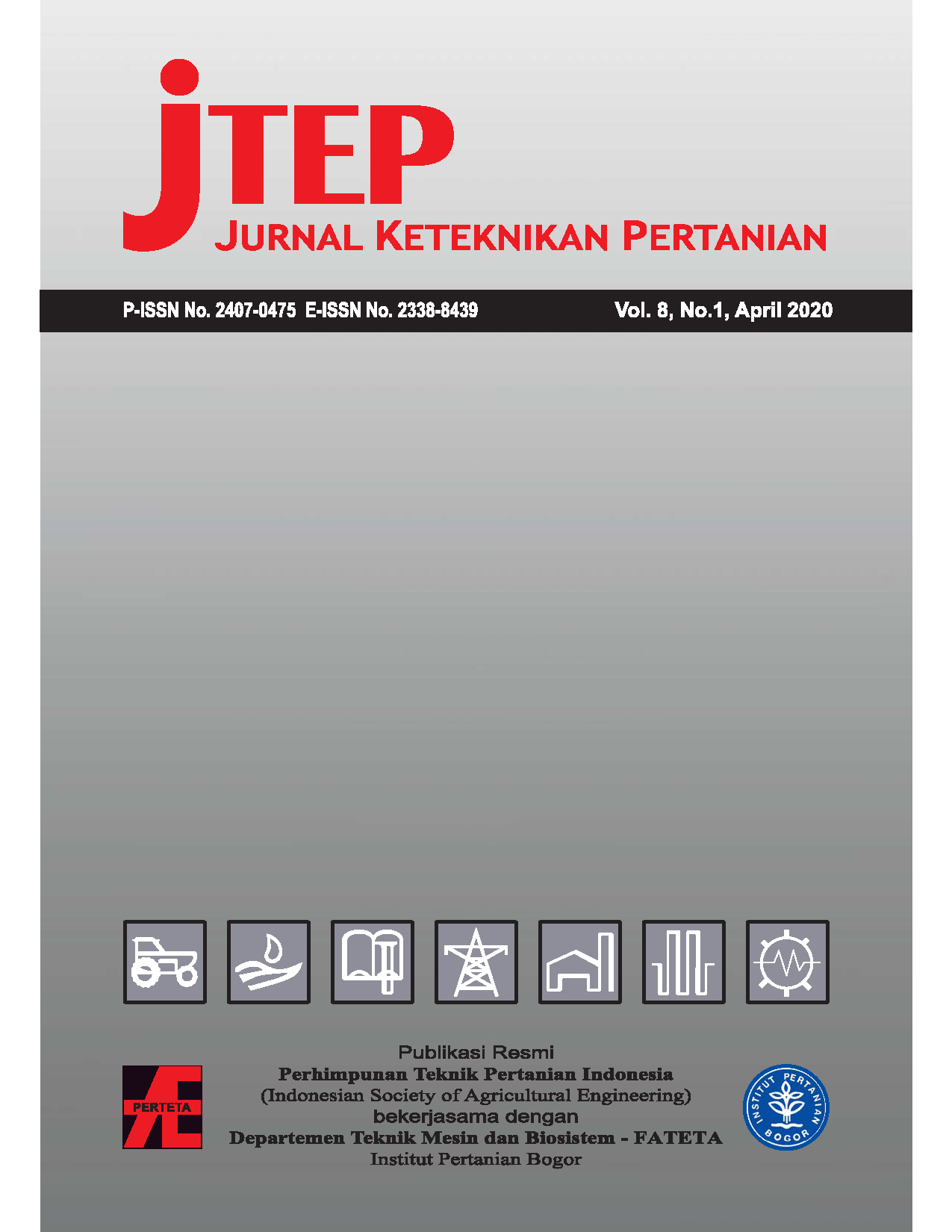Aplikasi Ozon Untuk Mempertahankan Kualitas Buah Duku
Abstract
Abstrak
Perawatan tanaman duku yang masih kurang baik, membuat buah duku yang dipanen berpotensi membawa kontaminan mikroorganisme dari lahan sehingga turut mempercepat kerusakan buah. Teknologi ozon telah banyak digunakan untuk menghambat perkembangan mikroorganisme pada penyimpanan hortikultura segar. Tujuan penelitian adalah mengkaji pengaruh durasi pemaparan ozon dengan laju 1.38x10-4 gram/detik terhadap perubahan mutu duku dalam penyimpanan. Durasi pemaparan ozon yang dikaji adalah 20, 40 dan 60 detik sebagai perlakuan. Penelitian dilakukan menggunakan Rancangan Acak Lengkap (RAL). Pertumbuhan mikroba diukur menggunakan uji TPC, sedangkan parameter mutu yang dikaji adalah perubahan warna, kekerasan, total padatan terlarut (TPT) dan susut bobot. Data dianalisa menggunakan ANOVA dan uji lanjut Duncan. Perlakuan ozon yang memberi efek tebaik adalah laju 1.38x10-4 gram/detik dengan paparan 60 detik. Perlakuan tersebut mampu menahan pertumbuhan mikroba hingga 6.11 (log cfu/g) dibanding kontrol pada hari ke enam penyimpanan dengan mutu duku yang lebih baik berdasarkan nilai TPT dan susut bobot dengan nilai masing-masing adalah 17.8 obriks dan 0.93%. Namun untuk parameter warna dan kekerasan buah, perlakuan ozon 40 detik menghasilkan nilai yang lebih baik. Pelakuan ozon dengan paparan selama 40-60 detik dapat diaplikasikan untuk mempertahankan mutu duku yang dikombinasikan dengan penyimpanan suhu 14 1oC.
Kata Kunci: ozon, buah duku, total plate count, durasi
References
Achen, M. and Yousef A.E. 2001. Efficacy of ozone against Escherichia coli O157:H7 on apples. J. Food Sci. Vol. 66(9):1380–4.
Aguayo, E., Escalona, V.H., and Artés, F. 2006. Effect of cyclic exposure to ozone gas on physicochemical, sensorial and microbial quality of whole and sliced tomatoes. J Postharvest Biology and Technology. Vol. 39(2):169–177.
Alencar, R.E., Leda, R.A.F., Michele, S.P., Andre, R.D.C., and Antonio, F.C.2014. Effectiveness of ozone on postharvest conservation of pear (Pyrus communis L.). J. Food Process Technol. Vol. 5(317):3-5.
An, J., Zhang, M., Lu, Q. 2007. Changes in some quality indexes in freshcut green asparagus pretreated with aqueous ozone and subsequent modified atmosphere packaging. Journal of Food Engineering. Vol. 78(1):340–4.
Asgar, A. 2014. Teknologi ozonisasi untuk mencuci sayuran. J. Iptek Hort. Vol. 1(10):10-13.
Barth, M.M., Zhou, C., Mercier J., Payne, F.A., 1995. Ozone storage effects on antocyanin content and fungal growth in blackberries. Journal of Food Science. Vol. 60(6):1286−1288.
Carreno, J., Almela, L., Martinez, A., and Fernandez-Lopez, J.A. 1995. Colour changes associated with maturation of the table grape cv. Don Mariano. Journal of Horticultural Science. Vol. 70(5):841–846.
[DTI] Danish Technology Institute. 2008. Guide Packaging Fresh Fruit and Vegetables. Innovation Act. Denmark. p 7-8.
Forney, C.F., Song, J., Hildebrand, P.D., Fan, L., and McRae, K.B. 2007. Interactive effects of ozone and 1-methylcyclopropene on decay resistance and quality of stored carrots. Postharvest Biology and Technology. J Sci. Food Agric. Vol. 45(3):341–348.
Hairunnisa, Nunung. 2014. Penyebab dan Pencegahan Browning pada Langsat (Lansium domesticum). Pontianak: Dinas Pertanian, Perikanan dan Kehutanan.
Glowacz, Marcin and Deborah, R, 2016. The practicality of using ozone with fruit and vegetables. J. Sci Food Agric. Vol. 96(14):4637-4643.
Lichanporn, I., Srilaong, V., Wongs-Aree, C., Kanlayaranat, S. 2008. Effect of strorage temperature on peel colour and physiological changes of longkong fruit (Aglaia dookkoo Griff). J. Acta Hort. Vol. 804:599-604.
Miller, F.A., Silva, C.L., Brandao, T.R. 2013. A review on ozone-based treatments for fruit and vegetables preservation. Journal Food Engineering Reviews. Vol. 5(2):77-106.
Nadas, A., Olmo, M., Garcia, J.M. 2003. Growth of Botrytis Cinerea and strawberry quality in ozone-enriched atmospheres. Journal of Food Science. Vol. 68(5): 1798–1802.
Nebel, C. 1975. Ozone decolorization of secondary dye laden effluents. Second Symposium on Ozone Technology, Montreal, May 11–14 (p 336−358).
O’Donnell, Colm, B.K., Tiwari, P.J. Cullen and Rip, G.R. 2012. Status and Trend of Ozone in Food Processing. Wiley-Blackwell a John Wiley & Sons, publishing Ltd: UK.
Ong, M. K., Ali, A., Alderson, P.G., and Forney, C.F. (2014). Effect of different concentrations of ozone on physiological changes associated to gas exchange, fruit ripening, fruit surface quality and defence-related enzymes levels in papaya fruit during ambient storage. Journal Scientia Horticulturae. Vol. 179():163–169.
Perez, A.G., Sanz, C., Rios, J.J., Olias, R., and Olias, J.M. 1999. Effects of ozone treatment on postharvest strawberry quality. Journal of Agricultural and Food Chemistry. Vol. 47(4):1652−1656.
Sapii, A.T., Norila, Y., Muda, P., Lin, T.S. 2000. Postharvest quality changes in dokong (Lansium domesticum Corr.) harvested at different stages of ripeness. Quality assurance in agricultural produce, ACIAR Proceedings Australia.
Sarasa, J., Rache, M.P., Puig, A., Ormed, M P., Mutuberria, P., and Ovellerio, J.L. 1993. Proceedings of the 11st Seminar: ozone world congress, San Francisco, [tanggal tidak diketahui]. p 91-105.
Spalding, D.H. 1968. Effects of Ozone Atmospheres on Spoilage of Fruits and Vegetables after Harvest. Marketing Research Report. Department of Agriculture: Washington, D.C.
Tilaar, M., Wih, W.L., Ranti, A.S., Wasitaatmadja, S.M., Suryaningsih, Junardy, F.D., Maily. 2007. Review of Lansium domesticum Correa and its use in cosmetics. J. Bol Latinoamericano y del Caribe de Plantas Medicinales y Aromaticas. Vol. 7(4):183-189.
Utama, I.M.S., Y. Setiyo, I.A.R.P. Puja dan N.S. Antara. 2011. Kajian atmosfir terkendali untuk memperlambat penurunan mutu buah mangga arumanis selama penyimpanan. Jurnal Horikultura Indonesia.Vol. 2(1):27-33.
Yanuriati, A., Parwiyanti, Prabawati, Yulianingsih. 2007. Inhibition of Duku (Lansium Domesticum) spoilage using ozone. Proceeding of the 1st International Seminar: Current Issues and Challenges in Food Safety. Science-Based Approach for Food Safety Management. [tempat dan tanggal tidak diketahui]. p 287-289.
Authors

This work is licensed under a Creative Commons Attribution 4.0 International License.
Authors submitting manuscripts should understand and agree that copyright of manuscripts of the article shall be assigned/transferred to Jurnal Keteknikan Pertanian. This work is licensed under a Creative Commons Attribution-ShareAlike 4.0 International License (CC BY-SA) where Authors and Readers can copy and redistribute the material in any medium or format, as well as remix, transform, and build upon the material for any purpose, but they must give appropriate credit (cite to the article or content), provide a link to the license, and indicate if changes were made. If you remix, transform, or build upon the material, you must distribute your contributions under the same license as the original.

